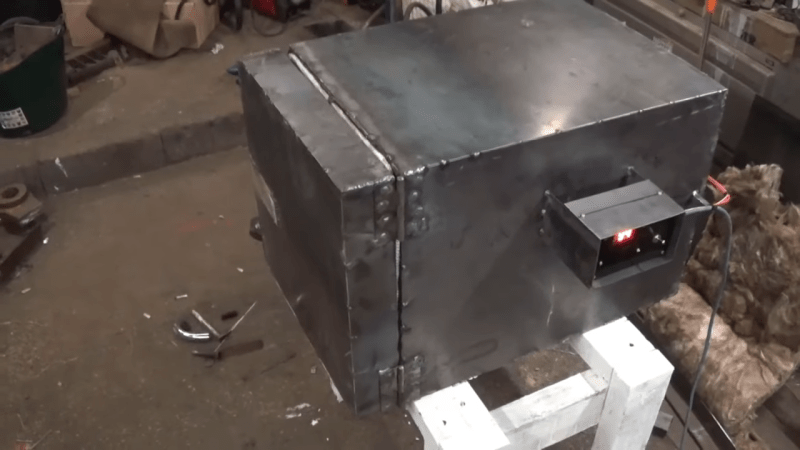When [Turbo Conquering Mega Eagle] tried lost wax casting, he ended up with a fireball and a galvanizing sense of disappointment. There wasn’t enough heat to get all the wax out, and the paraffin ignited. Though a bit burned by the experience, it didn’t extinguish his desire to do lost wax casting. In a textbook case of project-spawns-project, this eagle decided to wing it and made his own high-temperature oven.
This is true, seat-of-your-pants DIY. For this project, [TCME] treated himself to a virgin sheet of mild steel, a metallic delicacy for a guy who seems used to using whatever is available. The oven consists of a welded-together box inside a larger box, with insulation between the two. The door is a shallower box filled with insulation, with hinges on the right and a sturdy-looking gravity catch on the left. [TCME] welded together a nice little box for the 12-volt, 1000 °C temp controller module, and tacked some tabs to the outside to help wrangle the wires. Lower your visor and click past the break to watch this hot box come together.
We hope [TCME] answers the burning questions of how well the thing loses wax, and how fast it bakes a pizza. Meantime, here’s a clay oven that’s built to pizza.
















Sweet!
I love this place. This is really awesome, and the timing couldn’t be more perfect. I’m in the middle of building a reflow oven with a similar construction and spent way too long today fighting some 16ga steel with sheet metal shears. I was going to cut the next few panels with a cutoff wheel freehand but love how he clamped a straight edge to it. Thank you for posting this!
For other people building burnout ovens, some suggestions: PLA doesn’t explode and masters printed with 5% infill have vastly less material to burn out. If you build the oven with standoffs on the base you can put a catchment tray on the bottom to gather the wax while it’s still liquid to drain it out, or you can put a hole in the base of the oven to drain the wax into a pan under the oven. (Note: don’t build your catchment pan out of aluminum, coz, well, ovens get hotter than the melting point of aluminum. Boy did I feel dumb…)
He built his with a side-opening door and I built mine with a bottom-hinged door. I wish I’d built it with a top-hinged door. The hinge edge seals the best and you lose most of your heat out of the top edge of the door.
I built mine using magnesium oxide bricks, which you can gouge with an oak dowel, it’s so soft. That let me put nichrome heating coils inset into the surface on three sides. If I did it again I’d put them in the top and the door as well, because it gives more even heat.
Making electrical connections in or near an oven is trickier than you’d think. Make the connections in open air so they stay much cooler than the resistance wire, for one thing: crimps don’t last long when one component is red hot.
Im not normally too active in the comments but after Kristina’s subtle hints I should probably add something! I always scroll through hackaday and it’s a constant inspiration!
I built this heavy as I’ll also be softening metals up in it, element is just from a domestic electric oven and the reason I went with this module instead of my preferred inkbird module was cost. The PCB with probe-£3.50 the 1000°c inkbird without probe is £15 if anyone can tell me how to make the soft panels for these modules I’d really appreciate it!